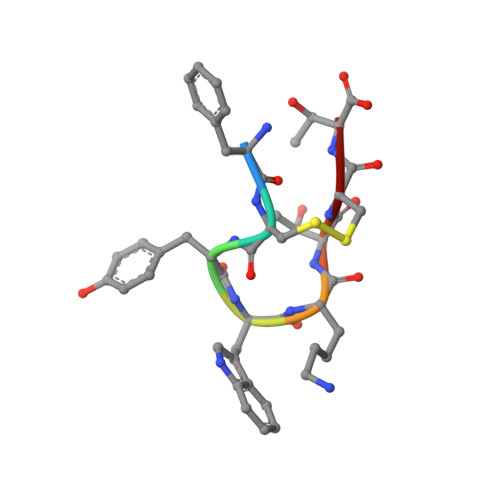3D solution structure of [Tyr3]octreotate derivatives in DMSO: structure differentiation of peptide core due to chelate group attachment and biologically active conformation.
Spyroulias, G.A., Galanis, A.S., Petrou, C.h., Vahliotis, D., Sotiriou, P., Nikolopoulou, A., Nock, B., Maina, T., Cordopatis, P.(2005) Med Chem 1: 487-499
- PubMed: 16787334
- DOI: https://doi.org/10.2174/1573406054864089
- Primary Citation of Related Structures:
1YL8, 1YL9 - PubMed Abstract:
The solution models of [Tyr3]octreotate (DPhe1-Cys2-Tyr3-DTrp4-Lys5-Thr6-Cys7-Thr8-COOH, disulfide bridged) (I), its analogs functionalized with an open chain tetraamine chelator, N4-[Tyr3]octreotate (II), and the N4-(Asp)2-[Tyr3]octreotate (III) peptide have been determined through 2D 1H NMR spectroscopy in DMSO. Chemical shift analysis has been performed in an attempt to elucidate structural changes occurring during attachment of the tetraamine to the peptide backbone. NMR-derived geometrical constraints have been used in order to calculate high resolution conformers of the above peptides. Conformational analysis of the three synthetic analogues, have shown that these somatostatin analoges adopt a predominant antiparallel beta-sheet conformation characterized by a beta-like turn spanning residues DTrp4 and Lys5 which is supported in the case of N4-(Asp)2-[Tyr3]octreotate and N4-[Tyr3]octreotate by medium range NOEs. These data indicate that the above-mentioned molecules adopt a rather constrained structure in the 4-residue loop Tyr3-Thr6. Additionally, the C-terminal of [Tyr3]octreotate, comprising Cys7 and Thr8, appears to form a turn-like structure manifested by characteristic side-chain NOEs between Lys5 and Thr8, which have not been detected for the other two compounds. These data are discussed in the light of previous structural data of Sandostatin (octreotide) and suggest that attachment of the N4-chelator and two Asp residues at the N-end of [Tyr3]octreotate impose considerable structural changes and affect the binding properties of these peptides. Indeed, the IC50 values determined during competition binding assays against the sst2 (somatostatin subtype 2 receptor) suggest that the presence of the N4 group enhances receptor affinity, while extension of peptide chain by two negatively-charged Asp residues impairs receptor affinity at approximately one order of magnitude.
Organizational Affiliation:
Department of Pharmacy, School of Health Sciences, University of Patras, Panepistimioupoli - Rion, GR-26504 Patras, Greece. G.A.Spyroulias@upatras.gr















